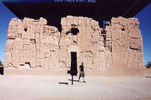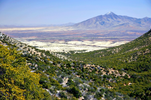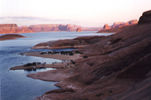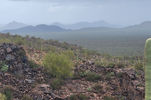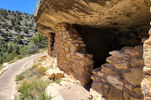Location & Access
The park is split into two districts—Tucson Mountain District (West) and Rincon Mountain District (East)—separated by the city of Tucson. Both districts are accessible by car and offer visitor centers, scenic drives, and trailheads.
Natural Features
Saguaro National Park showcases the Sonoran Desert, famous for its towering saguaro cacti, which can grow over 40 feet tall and live for 150+ years. The West District features desert valleys and volcanic rocks, while the East District rises into the Rincon Mountains, where oak and pine forests thrive at higher elevations.
Wildlife & Plants
The park is home to desert dwellers such as Gila monsters, desert tortoises, javelinas, coyotes, and bobcats. Birdlife includes Gila woodpeckers, cactus wrens, and Harris’s hawks. The plant life ranges from saguaros, prickly pear, and cholla to yucca and mesquite. Seasonal wildflower blooms paint the desert in spring.
Cultural & Historical Significance
The area has been home to Native peoples for thousands of years, with evidence of Hohokam petroglyphs and agricultural sites. Later, ranchers and settlers shaped the land before it was preserved as a monument in 1933 and upgraded to a national park in 1994. The saguaro cactus itself holds deep cultural significance for the Tohono O’odham people.
Recreation & Visitor Information
Both districts offer scenic drives such as the Cactus Forest Loop Drive (East) and Bajada Loop Drive (West). Hiking trails range from short desert walks to challenging backcountry treks into the Rincon Mountains. Visitor centers provide maps, exhibits, and ranger-led programs. Photography, stargazing, and wildflower viewing are popular activities.
Conservation & Management
Managed by the National Park Service, the park safeguards one of the most important habitats for saguaro cactus. Conservation efforts include invasive species management, wildfire prevention, and habitat restoration. Visitors are encouraged to stay on designated trails to protect the fragile desert environment.
Location: Pima County, Arizona, USA
Nearest City: Tucson, AZ
Size: ~91,716 acres
Established: March 1, 1933 (as monument); elevated to National Park October 14, 1994
Managed by: U.S. National Park Service
Visitation: ~1 million visitors annually




